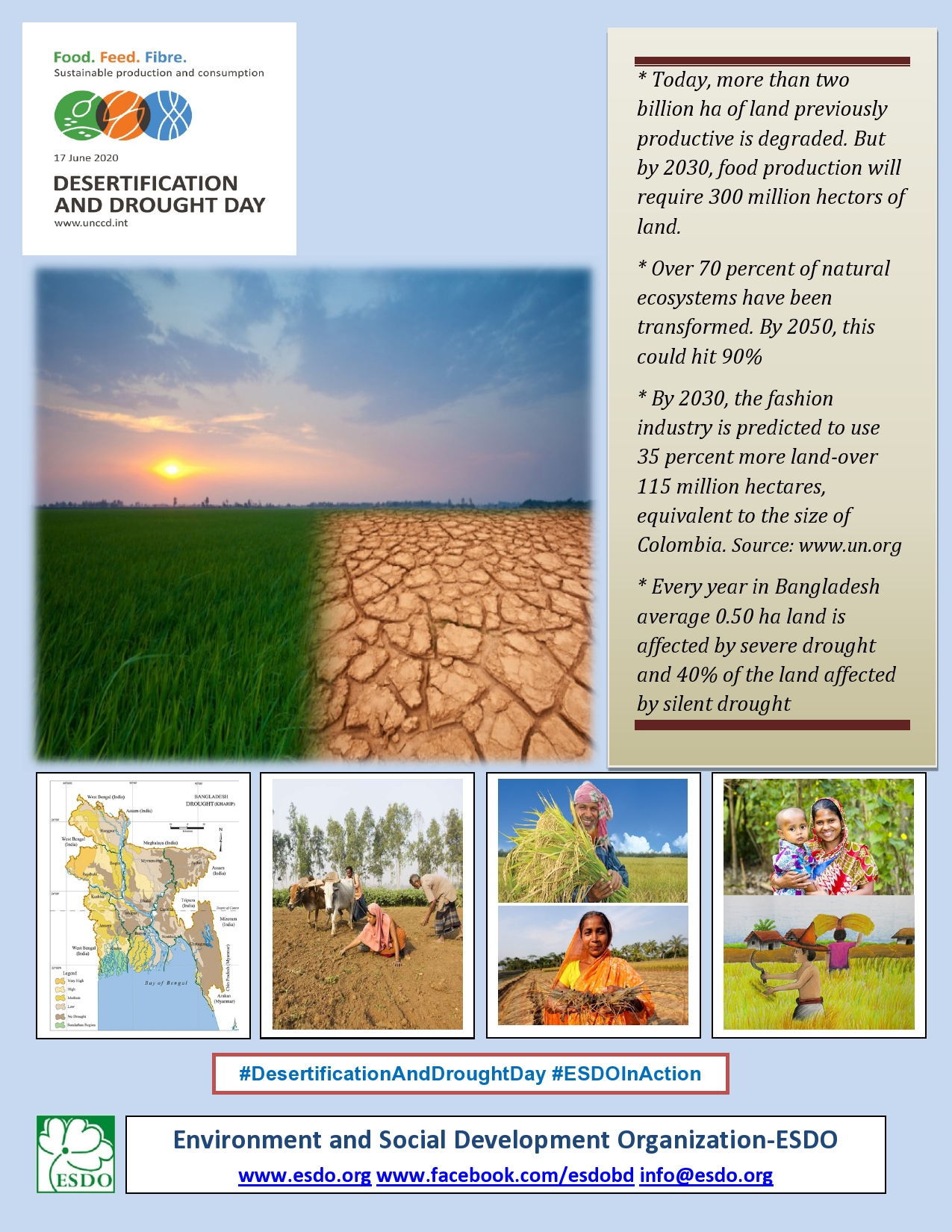World Day to Combat Desertification and Drought – 2020

World Day to Combat Desertification and Drought 2020
Desertification in Bangladesh:
Desertification is Bangladesh’s greatest problem with respect to the environment. Around 43% of the total geographical area has various types and degradation rates. Low soil fertility in drier areas of Bangladesh has been recognized as being the root cause of desertification. In the west-northwest of the country, total precipitation in the region is considered as the dry region. Land degradation caused by aridity and drought crop loss has caused more economic loss and human suffering in Bangladesh than any other problem.
Global situation:
- Today, more than two billion hectares of previously productive land is degraded globally
- Over 70 per cent of natural global ecosystems have been transformed. By 2050, this could hit 90 per cent
- By 2030, food production will require an additional 300 million hectares of land
- By 2030, the fashion industry is predicted to use 35 per cent more land – over 115 million hectares, equivalent to the size of Colombia
Desertification zones of Bangladesh:
The western-northwestern part of Bangladesh is considered as the drier region as total precipitation in the region is low. A country should have at least 25% forest coverage where Bangladesh has come down to 7-8%. And that is increasing the risk of desertification.
a) Modhupur- Barind- Lalmai region:
In Bangladesh, the islands of the Lalmai, Madhupur and Barind tracts are considered as the Pleistocene Terraces. It is a highly desertification area. Because of that the biodiversity loss of these regions are 450 species of invertebrates, 60 freshwater fish, 40 species of amphibians, 40 species of reptiles, 200 species of birds and 100 species of mammals in last 5 years.
b) Sylhet:
Sylhet has generally tropical semi-evergreen forest but has gone under desertification for past few years. Many endangered species are in the edge of extinction for desertification such as bison, deer, leopards, imperial pigeon, the green pigeon, and the white winged wood duck etc.
Silent ongoing Drought area:
a) Barisal:
Barisal region was known as granary of the state. This region mainly represents tidal wetland ecosystem of both saline and non-saline type. The crop production is restricted due to salinity in some areas during dry season. River bank erosion, exposure to cyclones and storm surges, risk of heavy late rainfall, torrential rain drip and remoteness of southern parts of the regions are the limitation of this area are the reason of its going under desertification.
Causes of desertification:
- Plastic pollution
- Industrialization
- Agriculture/ extensive use of chemical and fertilizer.
- Housing and communication development
- Mining
- Climatic condition and geological and geomorphologic setting (erratic rainfall, low humidity, high summer temperature, high degree of aridity, intense evapotranspiration, wind flow and high frequency of summer dust storms)
Remedy to Revive Desertification:
Bangladesh has a number of land degradation policies, but their application is limited. Existing initiatives and a range of new steps should put in place to tackle land loss. Some practical measures for combating desertification are following:
- Government need to adjust to the degree of desertificationthat a society faces or is likely to face. Prevention is a lot more cost-effective than rehabilitation, and this should be taken into account in policy decisions.
- In order to prevent and reverse desertification, major policy interventions and changes in management approaches are needed. Such interventions should be implemented at local to global scales, with the active engagement of stakeholdersand local communities.
- Government should strengthen sub-regional, regional and international cooperation under UN Convention to Combat Desertification (UNCCD).
- Adaptation of an integrated approach to address the physical, biological and socio-economic aspects of the desertification and drought is much needed.
- Government should build institutional capacity to conduct field level research for land degradation and applying the results to undertake appropriate preventive measures.
- In-situ protection and conservation of special ecological areas needs to be promoted through legislation, while ensuring the protection of biodiversity
- Ultimate industrialization needs to be stop in order to save the forests of Bangladesh.
- Zero Waste can be an alternative concept in order to combat desertification. If Zero waste principles is implemented in this case then it can reduce the risk of desertification to the half and could also help in reducing biodiversity loss.



